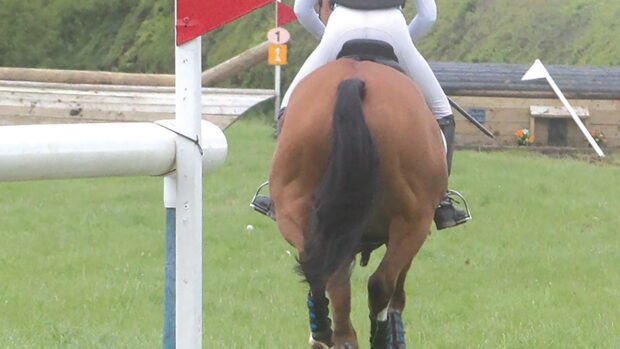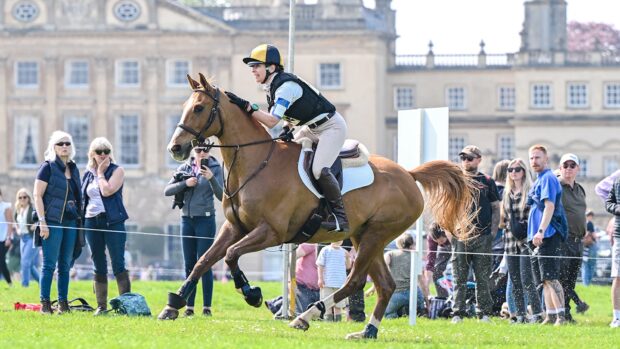If you're new to eventing, we have demystified the levels available both in the UK and internationally ahead of this season kicking off
There are six core eventing levels available to riders who compete in affiliated eventing in Britain under the organising body of British Eventing (BE).
BE80(T)
What it involves: The maximum height of fences at this level is 80cm (apart from two fences on the showjumping course which are allowed to be a maximum height of 85cm). The (T) in the name of this level represents training, whereby an accredited BE coach will be on hand at this level to give those competitors who wish to have it, some guidance throughout their day. Dressage tests are similar to that of basic British Dressage (BD) prelim. The cross-country course requires combinations to ravel at a speed of 435 metres per minute (mpm) to avoid time-penalties and fences will ask basic questions of horse and rider.
Best suited to: Anyone who fancies having a go. If you and your horse are fit and safe enough and competent competing at 85cm, then this is your ideal opportunity to give eventing a go without having to throw yourself down the Burghley Leaf Pit or into the Badminton Lake.
BE90
What it involves: The maximum height of fences at BE90 is 90cm in the showjumping and the cross-country (apart from two fences on the showjumping course which are allowed to be a maximum height of 95cm). Dressage tests are very similar to BD prelim standard and the cross-country requires combinations to travel at 450mpm to avoid incurring time-penalties.
Best suited to: As BE80(T) really. Anyone who wants to have fun over some slightly bigger fences, or an ideal level to introduce young horses to the world of eventing. This is the highest level a new competitor can start at. There are minimum eligibility requirements (MERs) riders must meet if they want to compete at BE100 level or above, details of which can be found here.
BE100
What it involves: The maximum height of fences at BE100 is 100cm in the showjumping and cross-country (apart from two fences on the showjumping course which are allowed to be a maximum height of 105cm). Again, dressage tests are similar to that of BD prelim but include more transitions than tests you will ride at BE80(T) and BE90 level. The speed horses and riders must travel at on the cross-country course is 475mpm.
Best suited to: The pinnacle of British Eventing grassroots competition, ideal for established BE90 competitors looking for a step up in technicality
Novice
What it involves: At BE novice level, fences in the showjumping are up to a maximum height of 1.10m (apart from two fences which are allowed to be a maximum height of 1.15m). In this phase you will also find treble combinations, unlike the smaller levels below it. Cross-country courses are up to 1.10m in height and more technical combinations will be introduced, including “skinnier” fences and more testing lines and the optimum time will require riders to travel at a quicker pace (520mpm). The dressage tests are similar to that of BD novice level and you can expect lengthened strides, basic lateral work and rein-back.
Best suited to: Quite a leap from BE100, BE novice is a good challenge for those who want to take their eventing seriously, amateur or otherwise
Intermediate
What it involves: The maximum height of fences at intermediate level is 1.20m (apart from two fences on the showjumping course which are allowed to be a maximum height of 1.25m). Much like novice level, there are more testing lines and trickier questions asked and the optimum time across country will be harder to reach due to the increase in pace required once again (550mpm). The showjumping time will also be tighter, and riders must make their way around the course at 350mpm. Intermediate dressage tests include more technical lateral work such as shoulder-in and travers and medium and extended movements are included.
Best suited to: Brave souls who are happy and confident to tackle large fences in quick succession on technical lines
Advanced
What it involves: This is the top level of BE competition. Fences are up to a maximum height of 1.25m (apart from two fences on the showjumping course which are allowed to be a maximum height of 1.30m) and the toughest questions are asked in both the showjumping and cross-country phases. Movements in the dressage include half-pass and flying changes, plus collection is required in an altogether more intense test.
Best suited to: The bravest of them all (both horse and rider!)
Interim levels
To accommodate for those wishing to get a taste of a level above the one they are competing at, BE offers interim levels of competition whereby the dressage and showjumping phases are of the same difficulty as the class above the one you are competing at. Interim competitions include, BE100Plus (dressage and showjumping are novice level, cross-country is BE100), BE105 (novice dressage, up to 1.10m showjumping and 1.05m cross-country), intermediate novice (dressage and showjumping are of intermediate standard and the cross-country is novice) and advanced intermediate (dressage and showjumping are advanced level but the cross-country remains at intermediate level.).
FEI levels
Those wishing to compete at international level are offered five tiers of competition. There are two types of FEI competition; one- (-S) and three-day (-L), where each of the following levels is represented.
One-star
What it involves: This level is new for 2019. The jumping phases will be 1.05m and the dressage test is likely to be something similar to that of BE100/novice tests.
Best suited to: Those with ambition to compete at international level and who are competing successfully at BE100/novice
Two-star
What it involves: This level is similar to that of BE novice and intermediate. The dressage tests include leg-yielding, rein-back and medium paces. The showjumping is up to 1.15m in height and the cross-country phase has a maximum height of 1.10m.
Best suited to: Those with ambition to compete at international level and who are competing successfully at BE novice
Three-star
What it involves: Three-star is in between BE intermediate and advanced in its technicality. The dressage is similar to BE intermediate but also includes walk pirouettes. The showjumping is up to 1.20m in height and the cross-country phase has a maximum height of 1.15m.
Best suited to: Those competing successfully at BE intermediate level
Like this? You might also enjoy reading these:
19 signs you’re an incurable eventing nut
Four-star
What it involves: Four-star is equivalent to BE advanced in both the technicality of the dressage test and the height of the jumping phases. The showjumping is up to 1.25m in height while the cross-country is up to 1.20m.
Best suited to: Anyone competing consistently at BE advanced level
Five-star
What it involves: The top level of eventing is five-star. The dressage test includes half-pass, multiple flying changes and much more. The maximum height of the showjumping is 1.30m and the cross-country is up to 1.20m and are both of ultimate technicality. On the cross-country course, the drops are bigger, narrow fences are skinnier, the brush on top of obstacles is taller and the width of spread enormous. Very few horse and rider combinations make it to four-star level, which makes it highly prestigious.
Best suited to: The crème de la crème of the eventing world. Think the Wimbledon of the tennis world and the Champions League Final of the football world. Something we can only dream about.
For all the latest news analysis, competition reports, interviews, features and much more, don’t miss Horse & Hound magazine, on sale every Thursday.




